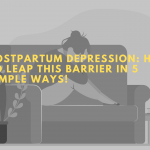In continuation of the series on anxiety, here’s the next update. In the last post, we talked about how do doctors treat anxiety once they diagnose it, various medications and methods with which you can support yourself and fight it away. Here we take a different perspective. Since you care about family members and friends, you can help them self-identify the lingering presence of anxiety if any. There are also misconceptions about anxiety and because it has various and blurry symptoms when it starts taking root, such that it becomes difficult to diagnose if one has anxiety or if one is simply stressed out.

First off, lets clear the air about myths surrounding anxiety.
- MYTH – ANXIETY ISN’T AN ILLNESS.
FACT– anxiety is very much a diagnosable illness that can be cured by optimum CBT and medications. There is a distinct difference between anxiety and general stress.
- MYTH – ANXIETY WILL GO AWAY ON ITS OWN.
FACT – symptoms of anxiety are very much persistent and do require a medical/psychiatric intervention to cure the individual suffering it.
- MYTH – ANXIETY IS NOT THAT COMMON.
FACT – anxiety is the most common psychological disorder until now. There are more people suffering from anxiety than those die of Cardiovascular Diseases.
- MYTH – SOCIAL ANXIETY IS SAME AS SHYNESS.
FACT – the difference between shyness and social anxiety is vast. Shyness is a part of someone’s nature and doesn’t trigger much upsetting, however social anxiety disrupts a person’s internal peace.
And now that we’ve dealt with general misconceptions surrounding anxiety let’s focus on how to catch the red flags going off around the person who has anxiety and hasn’t realized yet or is denying it.
WORRYING

People who have anxiety tend to overreact a bit too much to non-significant things of life. They do not see life from a passive perspective but from an overactive perspective which means that they pay extreme attention to minute details of life. This habit to examine life to such intricate levels of detail can easily lead them to overanalyze things and see ‘ghosts where there are none’. This is visible as well, they will become restless and worry over small things, imagine scenarios of outcomes which is a slippery slope. Eventually, they make a ‘mountain out of a molehill’ and spend a lot of mental energy and time worrying about nothing.
HELPLESSNESS

Helplessness or hopelessness is another outcome of constant dialogue with the inner self of the people. Those who suffer from anxiety tend to have a continuous dialogue with themselves and visit their memories and experiences over and over again. This leads to the development of an overwhelming feeling of hopelessness and decreased interest in life and activities. Their declined interests affect their productivity and overall performance.
MOOD SWINGS

The mood swings of individuals caused by the reasons as stated above are pretty much apparent, though they begin very subtly. The mood shifts triggered by stress and anxiety caused by stress is a self-sustaining cycle that can continue and worsen. Mood swings are another red flag that people tend to overlook. Yes, people do go through mood swings on a normal basis but those who have anxiety show very specific prolonged behavioral changes.
EMBRACING SOLITUDE

One of the outcomes of anxiety or even social anxiety is that people start leading a solitary life. They find their own presence much beneficial than going out and socializing with others. They find small talks, of the elevators or by the coffee machine in an office, tiring and draining their energy. You can observe their behavior to become more insulated and introverted over time, they’ll have a hard time sharing their issues with you and mostly hide the things that go on in their lives from you. If you’re a family member, you’ll see that their response to the question “How was your day today?” will be them either ignoring it entirely or giving one-word responses like ‘meh’ or ‘okay’ or ‘nothing intriguing happened today’. Yes, people do try to stay away from conversations at home after a hectic day at work but it becomes concerning when they start distancing themselves from their family and avoid even talking to them. It is one of the biggest red flags that working couples tend to overlook until the situation starts spiraling out of hands.
PERSISTENT FATIGUE

All of this inner dialogue and overthinking/overanalyzing comes at a cost. It exhausts the mind and body’s energy, making people feel tired all the time. Even after waking up in the morning. You can see a sharp decline in their overall efficiency and quality of work. It is normal to feel tired and spent after a long day at work but if you’re feeling tired all day long, there’s something off. You can observe that they no longer actively take part in activities. Their reservoir of enthusiasm seems to have developed a leak of some sort that keeps them devoid of it every time.
SELF – CONSCIOUSNESS

This is most apparent and kind of embarrassing for those who go through it. Observe it, they will avoid having to talk to you about anything other than official work. They probably will have a hard time maintaining eye contact and will look around or past you when talking. They will fumble around, let’s say they have to sign some paperwork around you, they’ll have a hard time getting it done. Their voice shall change a bit, scratch their nose or forehead. Probably even fidget while standing and talking to you. These symptoms are so disruptive that they make it hard for them to maintain relationships.
PERFECTIONISM

Okay, this has to be the most controversial of the symptoms posted on this list. The mindset of perfectionism and anxiety disorders occur together in most cases. If they’re taking more than required time to do a task such that they do not falter at any point in one of the red flags. With anxiety disorders even sometimes OCD can creep in (we’ve talked about OCD in detail on another post). OCD can develop subtly in tandem with anxiety. This illness pair has the potential to bring the life of the individual to a grinding halt. You know that the condition has gone a bit out of hands when they have the need to do the daily routine (rituals) in a specific order for a specific time to have a normal life. Keep an eye out for that.
By now we’ve managed to encompass almost all of the common yet subtle signs of anxiety disorder/ developing condition in regular people. Yes, the list can go on but that will most certainly overwhelm you with data and make a stressed-out guy look like a patient of anxiety to you; we don’t want to create confusion on such a serious issue.
However, you as a family member/ friend or a partner are better equipped now (after reading this post) to comprehend subtle symptoms of anxiety and how they appear to others. Thanks for reading, we’ll see you next time.








